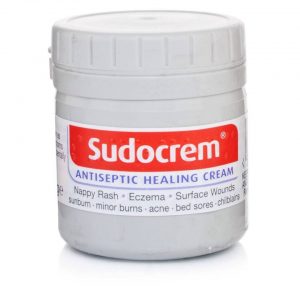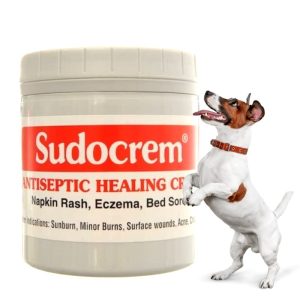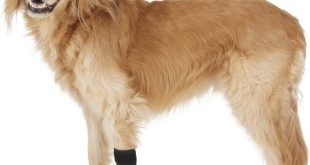You may notice your dog scratching the same area over and over causing sores or dragging its anus along the ground. These are typical signs that something is irritating your dog.
There are different possible reasons for these signs which could range from worms, infection, to inflammation. These skin conditions are common and can affect any dog breed. In this article we will be discussing Sudocrem Antiseptic Healing Cream and how it can help reduce irritation on your dog.
You can buy Sudocrem Antiseptic Healing Cream for your dog here.
Can you Use Sudocrem on Dogs
A common question we get is Can you put Sudocrem on a dog. The short answer is yes. When it comes to your furry friend’s health, it is always best to consult with a veterinarian before applying any human medications or products. Dogs have different skin compositions and sensitivities compared to humans, and what may be safe and effective for us may not be suitable for them. Veterinarians have the expertise to evaluate your dog’s condition and recommend appropriate treatments or alternatives that are specifically designed for animals.
-
Product on sale
 Sudocrem Antiseptic Healing Cream for Dogs 125gOriginal price was: $19.99.$17.99Current price is: $17.99.
Sudocrem Antiseptic Healing Cream for Dogs 125gOriginal price was: $19.99.$17.99Current price is: $17.99.
While some conditions can be treated at home, those that worsen over time should be taken seriously, and you should visit your vet. Your vet will carry out tests to determine what could be the cause of your dog’s skin condition, and what you can do about it. Your dog’s skin problems could be rashes, scabs or sores, Inflammation, Redness or discoloration, scaly patches, dry or flaky skin, bald patches, swelling, or lumps, Hot spots, dark spots.
Sudocrem Antiseptic Healing Cream is a multipurpose product that can help treat your dog’s rash and heal wounds and other skin issues. It serves both as an antibacterial and anti-inflammatory.
In this article we will be discussing how Sudocrem can help if you dog is suffering from any of these conditions. After we do that, we will delve into the conditions themselves and their causes.
Table of Contents
- What is Sudocrem Antiseptic Healing Cream
- What is Sudocrem made of
- How can you use Sudocrem
- Side effects of Sudocrem
- Is Sudocrem or toxic for dogs
- Conclusion
What is Sudocrem Antiseptic Healing Cream?

Sudocrem Antiseptic Healing Cream is a product that can help to relieve and treat your dog’s irritated skin and dermatitis. It contains antibacterial, antifungal, and mild anesthetic to soothe your dog’s irritated skin. This cream is sold worldwide due to its popularity.
What is Sudocrem Made of?
Sudocrem’s formula has remained unchanged since the product started selling in 1931. Its formula was designed to be soothing and to alleviate skin problems. Lets look at some of the main ingredients.
Main Ingredients In Sudocrem
Benzyl Alcohol
This is a skin medication used as an antiparasitic medication. It is used as a local anesthetic and antiseptic. When used to clean wounds, it reduces discomfort caused by irritation. This doesn’t apply to dogs alone, but also to humans. Benzyl alcohol is normally used in topical soaps and creams due to its antifungal and antibacterial properties.
Anhydrous Hypoallergenic lanolin
This is used as a moisturizer to treat and prevent dry rough scaly, and itchy skin, and minor skin irritations. It is effective for soothing and softening irritated skin.
The lanolin ingredient forms an oily layer on the top of the skin to hold moisture.
The lanolin on Sudocrem helps to reduce your dog’s amount of itchy skin and is considered safe.
Zinc Oxide
This is the ingredient that brings the most concern when using Sudocrem on dogs. If a dog consumes this in large quantities, he could develop of Zinc toxicosis. Zinc oxide is used to treat or prevent minor skin irritations such as burns, cuts, and rash.
Also, this cream may be applied as sunscreen. It forms a barrier on the skin which protects the skin from moisture and other factors that irritate it.
However, this must be only used externally on your dog’s skin as it is not meant for ingestion and is toxic if ingested. You should not use it if the affected area is infected.
How can you use Sudocrem?
Before using Sudocrem on your dog, ensure that your dog is not a self-licker. Also, do not apply too much Sudocrem as it will only tempt your dog to lick it off. Take a moderate amount of the cream and rub it on the affected area. It should soak into your dog’s skin after a short time.
Can you use Sudocrem on Dogs Ears, Eyes or Mouth?
Caution: Never use Sudocrem around your dog’s eyes, mouth, nose, inside ears. You can apply it safely on the base of its tail, legs, paws, neck, head, back, rear, and around its genitals.
Is Sudocrem Toxic for Dogs?

If used appropriately Sudocrem is very safe. However, it should be used with extreme care. It contains Zinc oxide, which if consumed in large amounts can cause zinc toxicosis in your dog. This is the only known side effect of Sudocrem. Here are some of the symptoms; Vomiting, Lethargy, weight loss, anemia, weakness, diarrhea.
These are a few signs that your dog has consumed too much zinc due to using Sudocrem. Take your dog to your vet if you suspect this is the case.
RASHES
This appears in the form of reddish spots on your dog’s skin and is more common around its abdomen.
These could all be as a result of Contact Dermatitis, which happens when your dog comes into contact with an irritant such as chemicals or fertilizers.
If you confirm that the rashes are a result of contact dermatitis, wash the affected area to clear off irritants that may still be present on your dog’s skin.
If it is caused by Insect bites, it may not affect your dog at all, and treatment is not required.
SCABS
There are many reasons your dog may have a scab. Some of these reasons include food allergies, cuts, or injuries. If your dog is constantly scratching its skin causing scabs, it is a sign that he is uncomfortable with itchy skin.
Scabs can appear in most areas of your dog’s body, but the back and neck areas are the most common zones for them to appear. They form as a result of the bursting of short-lived pustules or pimples.
They can also be caused by Parasites
Parasites are tiny insects that feed off your dog. You may not be able to see them, but there are signs and symptoms. Different types of parasites can cause your dog scabs. These include:
Ticks
Ticks stay on the body of your pet and feed off its blood. This can make your dog feel irritation on its skin causing it to scratch its body. This can lead to the formation of scabs. You can remove ticks by yourself with a tick twister. But you must ensure to take the head of the tick out of your pet otherwise they can cause an Infection.
Fleas
Fleas cause your dog to have itchy skin which leads them to scratch and lick it. This is a result of the sharp pain fleas cause when they bite. Their salivary glands also emit a substance that is irritating to many dogs.
Adult fleas are reddish-brown and very thin and are more visible on light-colored dogs. They also leave behind “flea dirt” which looks like pepper and is visible on your dog’s bedding and its favorite places around the house.
Allergens and Scabs

Pollen
When your dog is allergic to pollen, you will notice him licking, biting, and scratching his body a lot. This is because pollen must have fallen on your dog’s fur, ears, and the pads on its paw. Your dog will try to soothe itself by licking, chewing, and scratching those affected areas. When this becomes excessive, it can lead to hair loss and scabbing.
You can help your dog by wiping its paws to remove pollen several times a day. Take a trip to the vet if the condition doesn’t get better.
Food
Foods can cause your dog to have an allergic reaction in different ways. One of the common signs of this is skin irritation. When you notice your dog having rashes or scabs after eating a specific food, it is a sign that the food is not right for your dog.
Another cause of scabs could be infections. Types of Infections to look out for
Bacterial infection
The most common is bacterial folliculitis, which appears as a bump on your dog’s skin. This happens when the inflammation of hair follicles becomes infected.
Fungal infection
Usually caused by ringworm. Your dog’s skin appears scaly, red, and irritated. And this can lead to hair loss.
Sudocrem for Dogs Yeast Infection
Yeast Infection
Excessive amounts of yeast can build up in warm or moist areas and cause your dog to have itchy dry skin and discolored patches.
Sores
Sores on your dog are caused by an infection called Superficial Bacterial folliculitis. This is more easily seen on short-haired dogs than on long-haired dogs. Your dog may show symptoms such as wounds with scaly skin underneath.
Please note that any sore that does not have an obvious cause or refuses to heal might be a sign of cancer and other disorders. Therefore it is important to check with your vet immediately if that is the case.
DRY OR FLAKY SKIN
Dry or flaky skin on your dog can be as a result of more serious conditions such as the ones mentioned below.
Seborrhea
A skin disorder that makes the sebaceous glands of your dog’s skin produce an excessive amount of sebum causing its skin to be dry, scaly, and itchy.
It usually affects the skin along your dog’s back, and the affected areas flake off in whitish dandruff that can be seen on your dog’s bedding, or other places it lies.
Cheyletiellosis (Walking Dandruff)
This condition is uncommon but also highly contagious. It is a skin parasite caused by mites. It is called walking dandruff due to the appearance of whitish mites as they crawl across your dog’s skin, and the excessive scaling that follows the infection. This condition is very rare.
It could also be a result of dry skin. So, you should make sure your dog consumes good quality foods rich in omega-3s and omega-6 fatty acids.
HOTSPOTS (moist dermatitis)
They can be found anywhere o. your dog’s body and can increase in size very quickly. They are itchy and painful to your dog. This will make your dog try to soothe itself by scratching, licking, and biting the affected areas.
DARK SPOTS (Hyperpigmentation)
This is the darkening and thickening of your dog’s skin. Usually it is not a specific disease, but a reaction of your dog’s body to certain conditions. Additionally, it could also be related to a hormone disorder or could be skin damage due to the sun or constant friction.\
Conclusion
Sudocrem can be applied to both dogs and humans. It should be used with extreme care, as ingestion can lead to zinc toxicosis.
 Total Pooch Dog Supplements, Tear Stain Removers, De-wormers, Tylosin for Dogs and other great products.
Total Pooch Dog Supplements, Tear Stain Removers, De-wormers, Tylosin for Dogs and other great products.




